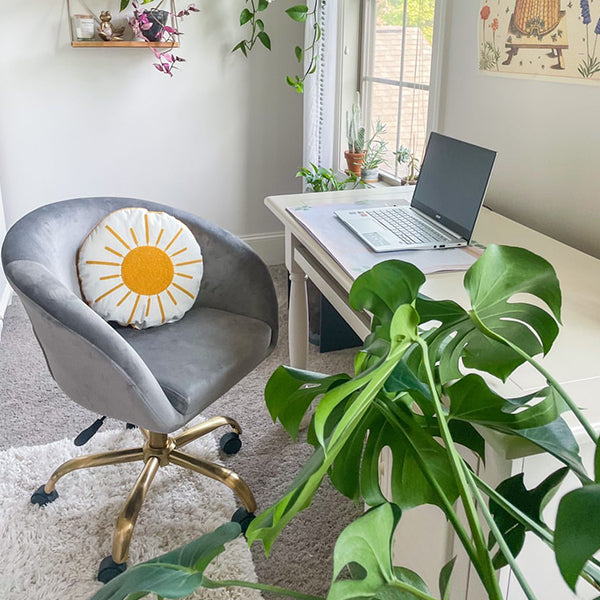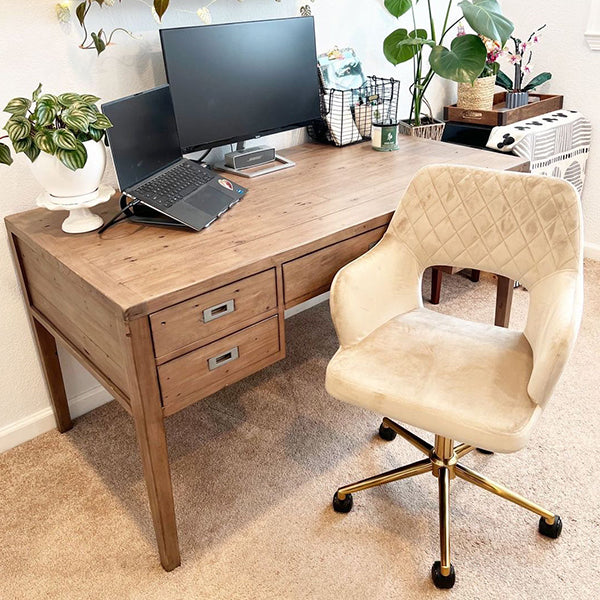How Do You Select Your Home Office Chair?

Duhome Furniture .
Nov 26, 2023
Introduction
As a freelancer, my first home office chair was an old, rickety kitchen chair. It wasn't easy on the eyes and it certainly wasn't easy on my back. I knew I had to upgrade, but where do you even start? In this blog post, we'll look at five key factors in selecting your home office chair so that you can spend less time sitting and more time working.
Comfort
The most important aspect of any office chair is comfort. The idea that you'll be sitting in your home office all day, every day for eight hours straight may not appeal to everyone. However, if this is the case for you and you want to get the best productivity possible out of your home office experience, comfort should be a top priority when purchasing a new chair.
There are two main components to consider when deciding on which chair will provide the most comfort: body size and shape (and the type of work you do). For example, if you're tall with long arms and legs or have lower back problems, a taller chair would likely suit your needs best. Since it allows room for leg movement while still providing ample support around the calf area. Additionally, if typing at an angle causes pain in one arm or shoulder over time due to its proximity to said body part as well as poor posture while doing so (as many people tend toward), you can look into getting an ergonomic keyboard tray attachment instead, so keys are within reach without having them right beneath them all day long!

Ergonomics
You should also consider ergonomics, or how a piece of furniture fits your body. Ergonomic design can help prevent injuries and discomfort for people who spend a lot of time sitting down. If you're going to be working from home in front of your computer all day long, it's important that the chair is comfortable enough so that you don't have to worry about getting up every hour when your back is killing you - or worse yet, developing chronic pain issues because your body isn't getting the support it needs during extended periods of sitting.
The right chair will keep your muscles relaxed while still supporting them enough so they don't feel sore after hours at a time spent seated. The best way to ensure this is through proper posture: sit with good posture by keeping both feet flat on the floor (if possible), sitting up straight without slouching or leaning forward too much, breathing evenly through your nose if possible (though this may not always be possible depending on where exactly in the world one lives), placing an elbow on each armrest and hands together under chin (which will keep shoulders relaxed).
Adjustability
Adjustability is a critical feature to consider when purchasing a chair. You want to be able to make adjustments that suit your body and work style.
●Height adjustment: The height of the desk chair should allow you to sit in a position that is comfortable for your work activities. Adjustable height allows for an array of positions, from sitting at full-height or lower than your desk so as not to put stress on your knees and back.
●Tilt: Chairs with tilt mechanisms allow users to change the angle of the seat itself, which can help relieve pressure from sensitive areas such as the tailbone or knees - especially if you're using it for long periods of time! Make sure this option has infinite lock (there should be no limit) so that it doesn’t keep sliding back into place after adjustments have been made.
●Backrest: We all know how important our backs are; they support most of our weight while we sit - which means they need proper support if we want them healthy! Most office chairs come with adjustable backrests, so users can find their perfect position based on their needs and preferences - when working at home or in an office environment, where different tasks require different bodily positioning depending on what needs doing first before moving onto something else later down line (kudos if anyone gets what I mean there). However, some people prefer flat backs, because they feel like more natural way imagine being supported by something solid rather than having extra padding pushing against them all throughout working day.

Style
You should consider the style of your chair as well. Are you going for a traditional look, or would you prefer something more modern? Do you have a certain color scheme that fits with your office space? How about budget - will the price tag make it difficult to purchase this type of chair? These are all things to think about when deciding what kind of chair will work best in your home office.
Convenience
●Your office chair should be easy to move around.
●It should be easy to clean and maintain.
●You want a warranty that covers the chair's parts and labor as well as the frame's structural integrity (and any other issues) for at least five years.
●Look for an assembled option, which is more convenient than having to put together all of the pieces yourself.
Figure Out What You Need in a Home Office Chair:
●Write down all the features and qualities you want in your chair, and keep it handy for when you're shopping around.
●For example, if your current chair isn't comfortable enough for long hours of sitting and working, then it's important to find one that is.
Conclusion
Hopefully, this article has been helpful in providing some insight into what you need to consider when choosing your office chair. If you have any questions about the process or would like to discuss your options further, don't hesitate to reach out - we're always happy to talk!
As a freelancer, my first home office chair was an old, rickety kitchen chair. It wasn't easy on the eyes and it certainly wasn't easy on my back. I knew I had to upgrade, but where do you even start? In this blog post, we'll look at five key factors in selecting your home office chair so that you can spend less time sitting and more time working.
Comfort
The most important aspect of any office chair is comfort. The idea that you'll be sitting in your home office all day, every day for eight hours straight may not appeal to everyone. However, if this is the case for you and you want to get the best productivity possible out of your home office experience, comfort should be a top priority when purchasing a new chair.
There are two main components to consider when deciding on which chair will provide the most comfort: body size and shape (and the type of work you do). For example, if you're tall with long arms and legs or have lower back problems, a taller chair would likely suit your needs best. Since it allows room for leg movement while still providing ample support around the calf area. Additionally, if typing at an angle causes pain in one arm or shoulder over time due to its proximity to said body part as well as poor posture while doing so (as many people tend toward), you can look into getting an ergonomic keyboard tray attachment instead, so keys are within reach without having them right beneath them all day long!

Ergonomics
You should also consider ergonomics, or how a piece of furniture fits your body. Ergonomic design can help prevent injuries and discomfort for people who spend a lot of time sitting down. If you're going to be working from home in front of your computer all day long, it's important that the chair is comfortable enough so that you don't have to worry about getting up every hour when your back is killing you - or worse yet, developing chronic pain issues because your body isn't getting the support it needs during extended periods of sitting.
The right chair will keep your muscles relaxed while still supporting them enough so they don't feel sore after hours at a time spent seated. The best way to ensure this is through proper posture: sit with good posture by keeping both feet flat on the floor (if possible), sitting up straight without slouching or leaning forward too much, breathing evenly through your nose if possible (though this may not always be possible depending on where exactly in the world one lives), placing an elbow on each armrest and hands together under chin (which will keep shoulders relaxed).
Adjustability
Adjustability is a critical feature to consider when purchasing a chair. You want to be able to make adjustments that suit your body and work style.
●Height adjustment: The height of the desk chair should allow you to sit in a position that is comfortable for your work activities. Adjustable height allows for an array of positions, from sitting at full-height or lower than your desk so as not to put stress on your knees and back.
●Tilt: Chairs with tilt mechanisms allow users to change the angle of the seat itself, which can help relieve pressure from sensitive areas such as the tailbone or knees - especially if you're using it for long periods of time! Make sure this option has infinite lock (there should be no limit) so that it doesn’t keep sliding back into place after adjustments have been made.
●Backrest: We all know how important our backs are; they support most of our weight while we sit - which means they need proper support if we want them healthy! Most office chairs come with adjustable backrests, so users can find their perfect position based on their needs and preferences - when working at home or in an office environment, where different tasks require different bodily positioning depending on what needs doing first before moving onto something else later down line (kudos if anyone gets what I mean there). However, some people prefer flat backs, because they feel like more natural way imagine being supported by something solid rather than having extra padding pushing against them all throughout working day.

Style
You should consider the style of your chair as well. Are you going for a traditional look, or would you prefer something more modern? Do you have a certain color scheme that fits with your office space? How about budget - will the price tag make it difficult to purchase this type of chair? These are all things to think about when deciding what kind of chair will work best in your home office.
Convenience
●Your office chair should be easy to move around.
●It should be easy to clean and maintain.
●You want a warranty that covers the chair's parts and labor as well as the frame's structural integrity (and any other issues) for at least five years.
●Look for an assembled option, which is more convenient than having to put together all of the pieces yourself.
Figure Out What You Need in a Home Office Chair:
●Write down all the features and qualities you want in your chair, and keep it handy for when you're shopping around.
●For example, if your current chair isn't comfortable enough for long hours of sitting and working, then it's important to find one that is.
Conclusion
Hopefully, this article has been helpful in providing some insight into what you need to consider when choosing your office chair. If you have any questions about the process or would like to discuss your options further, don't hesitate to reach out - we're always happy to talk!
